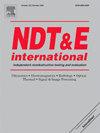SNR equalization in non-contact resonant ultrasound spectroscopy measurements
IF 4.1
2区 材料科学
Q1 MATERIALS SCIENCE, CHARACTERIZATION & TESTING
引用次数: 0
Abstract
It is proposed to replace the single pulse excitation with spread spectrum signal of programmable spectral shape in non-contact resonant ultrasound spectroscopy (NC-RUS). Bandwidth can be improved by pushing the signal energy towards high loss frequencies. It has been demonstrated that not just signal spectrum but also noise spectral density are irregular, therefore not only signal spectrum but SNR has to be equalized. The benefit of SNR-equalized signals in RUS is the improved SNR over broader bandwidth which results in better inverse solution convergence. Arbitrary position, and width pulses (APWP) sequences performed best. It was demonstrated that unipolar APWP signals can be used to obtain the acceptable performance of spectral shaping. Use of unipolar excitation allows for simpler electronics. While −20 dB bandwidth in case of pulse excitation was 480 kHz, APWP excitation produced 670 kHz bandwidth. The proposed was compared against pulse, linear frequency modulation (LFM) and nonlinear frequency modulation (NLFM) signals in NC-RUS measurements of plant leaf and polycarbonate plate. In leaf measurements, bias error in density estimation was 2 % with APWP signals while LFM resulted in 45 % and pulse in 60 % error. The polycarbonate sample velocity estimation error for polycarbonate sample using APWP signal was 0.2 %, while LFM was 10 times higher (2 %); density estimation error for APWP was 3 %, but LFM resulted in 36 %, NLFM error was 22 %, pulse excitation resulted in 12 % error.
非接触式共振超声光谱测量中的信噪比均衡
提出了用可编程谱形扩频信号代替单脉冲激励的非接触式谐振超声光谱(NC-RUS)方法。通过将信号能量推向高损耗频率,可以提高带宽。已经证明,不仅信号频谱,而且噪声频谱密度都是不规则的,因此不仅信号频谱,而且信噪比都必须均衡。RUS中信噪比均衡信号的优点是在更宽的带宽上提高了信噪比,从而获得更好的逆解收敛性。任意位置和宽度脉冲(APWP)序列表现最好。结果表明,单极APWP信号可以获得较好的频谱整形性能。使用单极励磁可以使电子学更简单。脉冲激励下的- 20 dB带宽为480 kHz,而APWP激励产生的带宽为670 kHz。将该方法与脉冲、线性调频和非线性调频信号在植物叶片和聚碳酸酯板的NC-RUS测量中进行了比较。在叶片测量中,APWP信号的密度估计误差为2%,LFM信号的误差为45%,脉冲信号的误差为60%。APWP信号对聚碳酸酯样品的速度估计误差为0.2%,而LFM是前者的10倍(2%);APWP的密度估计误差为3%,而LFM误差为36%,NLFM误差为22%,脉冲激励误差为12%。
本文章由计算机程序翻译,如有差异,请以英文原文为准。
求助全文
约1分钟内获得全文
求助全文
来源期刊

Ndt & E International
工程技术-材料科学:表征与测试
CiteScore
7.20
自引率
9.50%
发文量
121
审稿时长
55 days
期刊介绍:
NDT&E international publishes peer-reviewed results of original research and development in all categories of the fields of nondestructive testing and evaluation including ultrasonics, electromagnetics, radiography, optical and thermal methods. In addition to traditional NDE topics, the emerging technology area of inspection of civil structures and materials is also emphasized. The journal publishes original papers on research and development of new inspection techniques and methods, as well as on novel and innovative applications of established methods. Papers on NDE sensors and their applications both for inspection and process control, as well as papers describing novel NDE systems for structural health monitoring and their performance in industrial settings are also considered. Other regular features include international news, new equipment and a calendar of forthcoming worldwide meetings. This journal is listed in Current Contents.
 求助内容:
求助内容: 应助结果提醒方式:
应助结果提醒方式:


